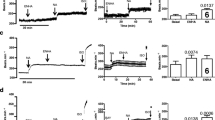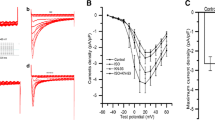Abstract
The role of the Ca2+-calmodulin dependent pathway of phospholamban phosphorylation on the relaxant effect of β-adrenergic agonists was studied in isolated perfused rat heart. Administration of the calmodulin antagonist W7 or lowering [Ca]0 from 1.35 mM (control) to 0.25 mM, were used as experimental tools to inhibit the Ca2+-calmodulin dependent protein kinase activity. 3×10−8 M isoproterenol increased cAMP levels from 0.613±0.109 pmol/mg wet weight to 1.581±0.123, phospholamban phosphorylation from 36±6 pmol32P/mg protein to 277±26 and decreased time to half relaxation (t1/2) from 61±2 msec to 39±2. Simultaneous perfusion of isoproterenol with 10−6 M W7, decreased phospholamban phosphorylation to 170±23 and prolongated t1/2 to 47±3 but did not affect the increase either in cAMP levels or myocardial contractility produced by isoproterenol. Similar effects on phospholamban phosphorylation and myocardial relaxation were obtained when isoproterenol was perfused in low [Ca]0. Low [Ca]0 did not affect the increase in cAMP elicited by isoproterenol but offset the positive inotropic effect of the β-agonist.
The results suggest a physiological role of the Ca2+-calmodulin dependent phospholamban phosphorylation pathway as a mechanism that supports, in part, the β-adrenergic cardiac relaxant effect.
Similar content being viewed by others
References
Katz AM: Excitation-contraction coupling. In: AM Katz (ed.) Physiology of the heart. Raven Press, New York, 1977, pp 137–159
Tada M, Yamada M, Kadoma M, Inui M, Ohmori F: Calcium transport by cardiac sarcoplasmic reticulum and phosphorylation of phospholamban. Mol Cell Biochem 46: 73–95, 1982
Kirchberger MA, Tada M, Katz AM: Adenosine 3′∶5′-monophosphate-dependent protein kinase catalyzed phosphorylation reaction and its relationship to calcium transport in cardiac reticulum. J Biol Chem 249: 6166–6173, 1974
Katz AM, Tada M, Kirchberger MA: Control of calcium transport in the myocardium by the cyclic AMP-protein kinase system. In: G Drummond (ed.) Advances in Cyclic Nucleotide Research. Raven Press, New York, 1975, pp 453–471
Le Peuch CJ, Haiech J, Demaille JG: Concerted regulation of cardiac sarcoplasmic reticulum calcium transport by cyclic adenosine monophosphate dependent and calcium-calmodulin-dependent phosphorylations. Biochemistry 18: 5150–5157, 1979
Bilezikjian LM, Kranias EG, Potter JD, Schwartz A: Studies on phosphorylation of canine cardiac sarcoplasmic reticulum by calmodulin-dependent protein kinase. Circ Res 49: 1356–1362, 1981
Tada M, Kirchberger MA, Repke DI, Katz AM: The stimulation of calcium transport in cardiac sarcoplasmic reticulum by adenosine 3′,5′-monophosphate-dependent protein kinase. J Biol Chem 249: 6174–6180, 1974
Katz S, Remtulla MA: Phosphodiesterase protein activator stimulates calcium transport in cardiac microsomal preparations enriched in sarcoplasmic reticulum. Biochem Biophys Res Commun 83: 1373–1379, 1978
Kirchberger MA, Antonetz T: Calmodulin-mediated regulation of calcium transport and (Ca2++Mg2+)-activated ATPase activity in isolated cardiac sarcoplasmic reticulum. J Biol Chem 257: 5685–5691, 1982
Simmerman HKB, Collins JH, Theibert JL, Wegener AD, Jones LR: Sequence analysis of phospholamban. Identification of phosphorylation sites and two major structural domains. J Biol Chem 261: 13333–13341, 1986
Vittone L, Mundiña C, Chiappe de Cingolani G, Mattiazzi A: Correlationship between myocardial relaxation and phospholamban phosphorylation. Acta Physiol Pharmacol Latinoam 38: 213–227, 1988
Grassi de Gende AO, Pérez Alzueta AD, Cingolani HE: Effect of isoproterenol on relation between maximal rate of contraction and maximal rate of relaxation. Am J Physiol 233: H404-H409, 1977
Vittone L, Grassi A, Chiappe L, Argel M, Cingolani HE: Relaxing effect of pharmacologic interventions increasing cAMP in rat heart. Am J Physiol 240: H441-H447, 1981
Lindemann JP, Jones LR, Hathaway DR, Henry BG, Watanabe AM: β-adrenergic stimulation of phospholamban phosphorylation and Ca2+-ATPase activity in guinea pig ventricles. J Biol Chem 258: 464–471, 1983
Lindemann JP, Watanabe AM: Phosphorylation of phospholamban in intact myocardium. Role of Ca2+-calmodulin-dependent mechanisms. J Biol Chem 260: 4516–4525, 1985
Mundiña de Weilenmann C, Vittone L, de Cingolani G, Mattiazzi A: Dissociation between contraction and relaxation: The possible role of phospholamban phosphorylation. Basic Res Cardiol 82: 507–516, 1987
Vittone L, Mundiña C, Chiappe de Cingolani G, Mattiazzi A: cAMP and calcium-dependent mechanisms of phospholamban phosphorylation in intact hearts. Am J Physiol 258: H318-H325, 1990
Napolitano R, Vittone L, Mundiña C, Chiappe de Cingolani G, Mattiazzi A: Decrease in tetanic tension elicited by beta-adrenergic stimulation. Arch Int Physiol Biochim Biophys 99: 303–307, 1991
Wegener AD, Simmerman HKB, Lindemann JP, Jones LR: Phospholamban phosphorylation in intact ventricles. Phosphorylation of serine 16 and threonine 17 in response to β-adrenergic stimulation. J Biol Chem 264: 11468–11474, 1989
Parmley W, Sonnenblick F: Relation between mechanisms of contraction and relaxation in mammalian cardiac muscle. Am J Physiol 216: 1084–1091, 1969
Mattiazzi A, Garay A, Cingolani HE: Critical evaluation of isometric indexes of relaxation in rat and cat papillary muscles and toad ventricular strips. J Mol Cell Cardiol 18: 749–758, 1986
Bradford MM: Rapid and sensitive method for the quantitation of microgram quantities of protein utilizing the principle of proteindye binding. Analyt Biochem 72: 248–254, 1976
Solomon Y, Londos C, Rodbell M: A highly sensitive adenylate cyclase assay. Anal Biochem 58: 541–548, 1974
Lamers JMJ, Stinis JT: Phosphorylation of low molecular weight proteins in purified preparations of rat heart sarcolemma and sarcoplasmic reticulum. Biochim Biophys Acta 624: 443–459 1980
Lamers JMJ, Heyliger CE, Panaglia V, Dhalla NS: Properties of 5′-nucleotidase in rat heart sarcolemma. Biochim Biophys Acta 742: 568–575, 1983
Louis CF, Hogan M, Turnquist J: Properties of the 23,000-Da phosphoproteins in cardiac sarcolemma and sarcoplasmic reticulum. Arch Biochem Biophys 246: 98–107, 1986
Laemmli UK: Cleavage of structural proteins during the assembly of the head of the bacteriophage T4. Nature (Lond) 227: 680–685 1970
Prozio MA, Pearson AM: Improved resolution of myofibrillar proteins with sodium-dodecyl sulfate-polyacrylamide gel electrophoresis. Biochim Biophys Acta 490: 27–34, 1977
Louis CF, Maffit M, Jarvis B: Factors that modify the molecular size of phospholamban, the 23,000 dalton cardiac sarcoplasmic reticulum phosphoprotein. J Biol Chem 257: 15182–15186, 1982
Barron JT, Bárány M, Bárány K: Phosphorylation of the 20,000-dalton light chain of myosin of intact arterial smooth muscle at rest and in contraction. J Biol Chem 254: 4954–4956, 1979
Steiner AL, Parker CW, Kipnis DM: Radioimmunoassay for cyclic nucleotides. I. Preparations of antibodies and iodinated cyclic nucleotides. J Biol Chem 247: 1106–1113, 1972
Harper JF: Peritz' F test: basic program of a robust multiple comparison test for statistical analysis of all differences among group means. Comput Biol Med 14: 437–445, 1984
Le Peuch CJ, Guilleux JC, Demaille JG: Phospholamban phosphorylation in the perfused rat heart is not solely dependent on β-adrenergic stimulation. FEBS Lett 114: 165–168, 1980
Asano M, Suzuki Y, Hidaka H: Effects of various calmodulin antagonists on contraction of rabbit aortic strips. J Pharmacol Exp Ther 220: 191–196, 1981
Asano M: Divergent pharmacological effects of three calmodulin antagonists, N-(6-aminohexyl)-5-chloro-1-naphthalenesulfonamide (W7), chlorpromazine and calmidazolium, on isometric tension development and myosin light chain phosphorylation in intact bovine tracheal smooth muscle. J Pharmacol Exp Ther 251: 764–773, 1989
Wermelskirchen D, Koch P, Wilhelm D, Nebel U, Leidig A, Wilffert B, Peters T: Effects of calmodulin antagonists on contraction and45Ca movements in rat aorta. Pharmacology 39: 317–326, 1989
Chan KM, Delfert DM, Koepnic SL, Mc Donald JM: Effect of W7 on Ca2+ uptake and Ca2+-ATPase activities of the endoplasmic reticulum of rat liver. Arch Biochem Biophys 256: 472–479, 1987
Zimmer M, Hofmann F: Calmodulin antagonists inhibit activity of myosin light-chain kinase independent of calmodulin. Eur J Biochem 142: 393–397, 1984
Hidaka HT, Yamaki T, Naka M, Tanaka T, Hayashi H, Kobayashi R: Calcium-regulated modulator protein interacting agents inhibit smooth muscle calcium-stimulated protein kinase and ATPase. Mol Pharmacol 17: 66–72, 1980
Hill TD, Campos-Gonzalez R, Kindmark H, Boynton AL: Inhibition of inositol triphosphate-stimulated calcium mobilization by calmodulin antagonists in rat liver epithelial cells. J Biol Chem 263: 16479–16484, 1988
Macdougall LK, Jones LR, Cohen P: Identification of the major protein phosphatases in mammalian cardiac muscle which dephosphorylate phospholamban. Eur J Biochem 196: 725–734, 1991
Cohen P, Cohen PTW: Protein phosphatases come to age. J Biol Chem 264: 21435–21438, 1989
Neumann J, Gupta RC, Schmitz W, Scholz H, Nairn AC, Watanabe AM: Evidence for isoproterenol-induced phosphorylation of phosphatase inhibitor-1 in the intact heart. Circ Res 69: 1450–1457, 1991
Author information
Authors and Affiliations
Rights and permissions
About this article
Cite this article
Vittone, L., Mundiña, C., Chiappe de Cingolani, G. et al. Role of Ca2+-calmodulin dependent phospholamban phosphorylation on the relaxant effect of β-adrenergic agonists. Mol Cell Biochem 124, 33–42 (1993). https://doi.org/10.1007/BF01096379
Received:
Accepted:
Issue Date:
DOI: https://doi.org/10.1007/BF01096379




